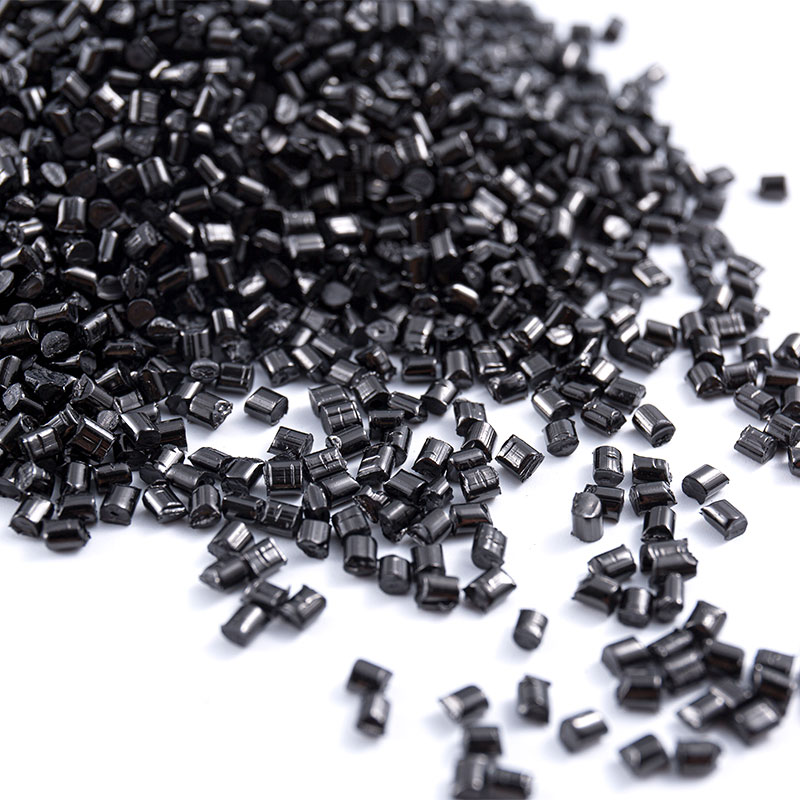What is the role of the PPS carrier in PPS Carrier Black Masterbatch?
PPS, as the carrier in PPS Carrier Black Masterbatch, is primarily used for coloring high-performance engineering plastics, especially suitable for applications requiring high heat resistance, high chemical stability, and low volatility, such as automotive electronics, electrical components, LED packaging, and chemical equipment.
The Core Role of the PPS Carrier
Pigment Dispersion Medium: The PPS carrier encapsulates and disperses pigments (such as carbon black) in the black masterbatch, ensuring uniform distribution of pigment particles during processing and preventing agglomeration.
Improved Compatibility: The PPS carrier and the PPS matrix material have the same chemical structure, guaranteeing extremely high compatibility and avoiding common problems such as interfacial delamination, flow marks, or uneven coloring.
Improved Thermal Stability:Since PPS decomposition temperatures are typically above 400 °C, it meets the stability requirements of black masterbatch in high-temperature injection molding or extrusion environments (e.g., 300–330 °C), preventing carrier degradation or bubble formation.
Performance Comparison with Other Carriers
|
Item
|
PPS Carrier
|
PE Carrier
|
PA Carrier
|
PC Carrier
|
|
Heat Resistance
|
Very High (>300°C)
|
Low (<130°C)
|
Medium (220°C)
|
High (260°C)
|
|
Compatibility (with PPS Matrix)
|
Excellent
|
Very Poor
|
Average
|
Poor
|
|
Dispersibility
|
Good (Matches Melt Viscosity)
|
Excellent (Low Viscosity)
|
Excellent
|
Average
|
|
Chemical Resistance
|
Excellent (Resistant to Acids, Alkalis, and Organic Solvents)
|
Poor
|
Medium
|
Moderately Good
|
|
Gas Release/Volatiles
|
Very Low
|
High
|
Medium
|
Medium
|
|
Typical Applications
|
PPS, PPS+GF, PPS+CF Systems
|
PE Film & Packaging
|
Engineering Plastics Coloring
|
Optical Components & PC Housings
|
Technical Highlights and Advantages
- PPS carrier maintains the mechanical strength and dimensional stability of the product, preventing interface defects caused by poor carrier compatibility;
- During high-temperature processing, it does not release low-molecular-weight substances, avoiding surface defects such as gas streaks, silver streaks, and pores;
- It can be used in reinforced systems (GF/CF reinforced PPS), maintaining stable pigment dispersion even under high shear conditions.
What is the mechanism by which PPS Carrier Black Masterbatch affects the surface quality of finished products?
PPS Carrier Black Masterbatch plays a decisive role in the surface appearance of finished products (such as gloss, color uniformity, and surface defects). Its influence mechanism is mainly related to carbon black particle size, dispersion state, and carrier melt flow behavior.
Analysis of Influence Mechanism
Influence of Pigment Particle Size
- The smaller the carbon black particle size (e.g., 15–20 nm), the larger the specific surface area, the enhanced light absorption and hiding power, resulting in a deep black, high-gloss surface effect.
- However, excessively small particle size will increase the agglomeration tendency, and if poorly dispersed, it will form "bright spots" or "pockmarks," reducing surface uniformity.
- Carbon black with a larger particle size (>50 nm) is easier to disperse, but its blackness is reduced and its gloss is poor.
Influence of Pigment Dispersion State
- Uniformly dispersed carbon black reduces light scattering and improves surface gloss;
- Poor dispersion leads to carbon black agglomeration, causing decreased gloss, uneven color, flow marks, or silver streaks;
- Dispersion also affects melt flow balance: areas with high local carbon black concentration alter the melt viscosity distribution, causing instability in the mold cavity flow, resulting in surface defects.
Influence of Carrier Rheological Behavior
- The high melt viscosity matching of PPS carriers with the matrix ensures uniform pigment distribution in the shear field;
- Using different carriers (such as PA, PC) with improper viscosity matching can lead to uneven pigment dispersion, forming flow marks or reflective streaks at the interface.
Contribution Ratio (Approximate Empirical Value)
|
Factor
|
Weight of Influence on Surface Gloss
|
Weight of Influence on Uniformity
|
|
Pigment Particle Size
|
≈ 40%
|
≈ 25%
|
|
Dispersion State
|
≈ 50%
|
≈ 60%
|
|
Carrier Flow Matching
|
≈ 10%
|
≈ 15%
|
Control and Optimization Methods
- Select carbon black with high structure and narrow particle size distribution (such as acetylene black or special furnace black) to obtain good blackness and gloss;
- Use a high-shear twin-screw extruder to improve dispersion;
- Adjust processing conditions (temperature, shear rate) to prevent pigment re-agglomeration;
- Use surface modifiers or dispersants (such as silanes) in the PPS masterbatch system to significantly reduce streaks and flow marks.
How does the choice of black pigment affect the performance of PPS masterbatch?
In PPS carrier black masterbatch systems, the selection of black pigment is one of the key factors determining material properties. Different types of carbon black exhibit significant differences in conductivity, blackness, thermal stability, and dispersion behavior, and these differences directly affect the appearance quality, service life, and processing stability of the final product.
Carbon Black Types and Performance Characteristics
|
Carbon Black Type
|
Particle Size (nm)
|
Structure (DBP Oil Absorption Value)
|
Conductivity
|
Blackness
|
Thermal Stability
|
Typical Applications
|
|
Furnace Black
|
15–80
|
Medium-High
|
Medium
|
Excellent
|
Excellent
|
General-purpose coloring PPS masterbatch
|
|
Acetylene Black
|
30–40
|
High
|
Very High
|
Excellent
|
Excellent
|
Conductive, Antistatic Masterbatch
|
|
Conductive Black
|
20–50
|
High
|
Very High
|
Good
|
Good
|
EMI Shielding, Conductive Plastics
|
|
Channel Black
|
10–30
|
Low
|
Low
|
Excellent
|
Poor
|
High-Gloss Appearance Products
|
The Influence of Carbon Black Selection on Key Properties of PPS Masterbatch
Conductivity and Electron Shielding Performance
High-structure acetylene black and conductive black can form a continuous conductive network in the PPS matrix, giving the composite material excellent electrical properties (volume resistivity can be reduced to 10³–10⁶ Ω·cm).
These formulations are commonly used in automotive electronics, electrical connectors, 5G communication housings, and EMI shielding components.
In contrast, furnace black, while possessing strong tinting strength, has moderate conductivity and is more suitable for structural components requiring high blackness but less stringent electrical performance requirements.
Tinting Strength and Appearance
Smaller carbon black particle size results in higher absorbance and better blackness and gloss in the finished product;
However, excessively fine carbon black particles (<20 nm) are prone to agglomeration, requiring sophisticated dispersion techniques.
In the PPS system, uneven dispersion can easily lead to surface bright spots, flow marks, or silver streaks.
Therefore, good rheological matching and surface wettability between the carrier and pigment are required.
Thermal Stability and Processing Compatibility
PPS is processed at temperatures as high as 300–330°C, so carbon black must possess excellent thermal stability.
Acetylene Black: High surface inertness, does not easily catalyze PPS degradation, suitable for components used in high-temperature, long-term applications.
Furnace Black: Contains surface functional groups; if not properly controlled, it may trigger oxidative degradation at high temperatures, leading to color difference or mechanical degradation.
Therefore, in high-end applications (such as LED brackets and automotive electronic control system housings), acetylene black or surface-treated conductive black is usually preferred.
Balance between Dispersibility and Mechanical Strength
The higher the carbon black structure (larger specific surface area), the more difficult it is to disperse, and it may also lead to an increase in melt viscosity.
High carbon black content (>20 wt%) reduces the impact resistance and ductility of PPS composites.
Therefore, an optimal balance must be achieved by optimizing the type of carbon black, carrier viscosity, and shear energy.
E-LUCK's Material Engineering Advantages and Technical Solutions
At E-LUCK, we deeply understand that the precise matching of black pigments and carrier systems is the core of high-performance masterbatches.
As a professional manufacturer and solution provider specializing in industrial black masterbatches, E-LUCK is committed to providing customized black solutions for high-end polymer applications, with precise dispersion, stable quality, and Material Intelligence as its core values.
E-LUCK's PPS carrier black masterbatch system utilizes:
- An optimized ratio of high-purity acetylene black and high-structure conductive black;
- A self-developed high-temperature dispersion process, ensuring uniform pigment dispersion even at 330°C;
- A PPS carrier system with precise viscosity control, perfectly compatible with the PPS matrix;
- A rigorous quality tracking system (Lot Traceability), guaranteeing batch-to-batch color difference <ΔE 0.5 and conductivity fluctuation <5%.
Leveraging these technological advantages, E-LUCK's black masterbatch is widely used in:
- Automotive Components (Electrical Connectors, Sensor Housings, Fuel System Components)
- Consumer Electronics and Electrical Equipment (LED Reflector Mounts, 5G Communication Housings)
- High-Performance Piping and Valve Systems (Chemical Corrosion Protection, High-Temperature Piping)
Industrial Films and High-Precision Molded Parts
By combining an advanced carbon black system with intelligent dispersion control, E-LUCK's PPS black masterbatch not only achieves deep color, uniform structure, and high thermal stability, but also achieves an industry-leading balance between conductivity and mechanical properties.

 English
English Español
Español










